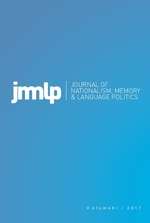Rock Beats the Wall? On Commemorative Practices in Post-Soviet Russia
Rock Beats the Wall? On Commemorative Practices in Post-Soviet Russia
Author(s): Nina Cingerová, Irina DulebováSubject(s): Semiotics / Semiology, History and theory of political science
Published by: Univerzita Karlova v Praze, Fakulta sociálních věd
Keywords: Memorial culture; Russia; Stalinism; discourse analysis; semiotic analysis
Summary/Abstract: This paper focuses on the case analysis of the memorial to the victims of state terror – the Wall of Grief (Stena skorbi) – which was unveiled on the eve of the 100th anniversary of the November 7, 1917, coup d’état. Using this example, we have attempted to elaborate a structure for a more complex analysis of the memory of past regimes’ manifestation and to create a methodological base for their comparison. We have based our research on the discourse theory by the so-called Essex School, the social semiotics by Kress, and the procedures of the critical discourse analysis. The procedure that we have considered relevant consists of the following: (a) description of the social context in which the memorial was manifested as a piece of evidence; (b) semiotic analysis of the memorial artifact; (c) analysis of verbal practices, as well as written and spoken texts that “explained” the memorial; and (d) analysis of nonverbal practices, namely, rituals. On the basis of our case study, we have come to the conclusion that when carrying out a semiotic analysis and the analysis of verbal and nonverbal practices in the case of the Russian public discourse, it is especially relevant to pay attention not only to widening vs. narrowing of the chronological framework, generalization vs. concretization, and specification of the traumatic experience but also to the question of framing of the memorial. In regard to the semiotic analysis, the extent of indexicality is considered to be very important in the sense of the bodily connection with an element of the commemorated event that bestows “truthfulness” and authenticity on the memorial. We assume that particularly present-day Russia, where explicit attempts to reinterpret the history of the authoritarian communist state and attempts to instrumentalize the totalitarian period according to the vector of the current political direction may be seen, is a relevant object of this kind of research.
Journal: Journal of Nationalism, Memory & Language Politics
- Issue Year: 14/2020
- Issue No: 01
- Page Range: 71-91
- Page Count: 21
- Language: English

